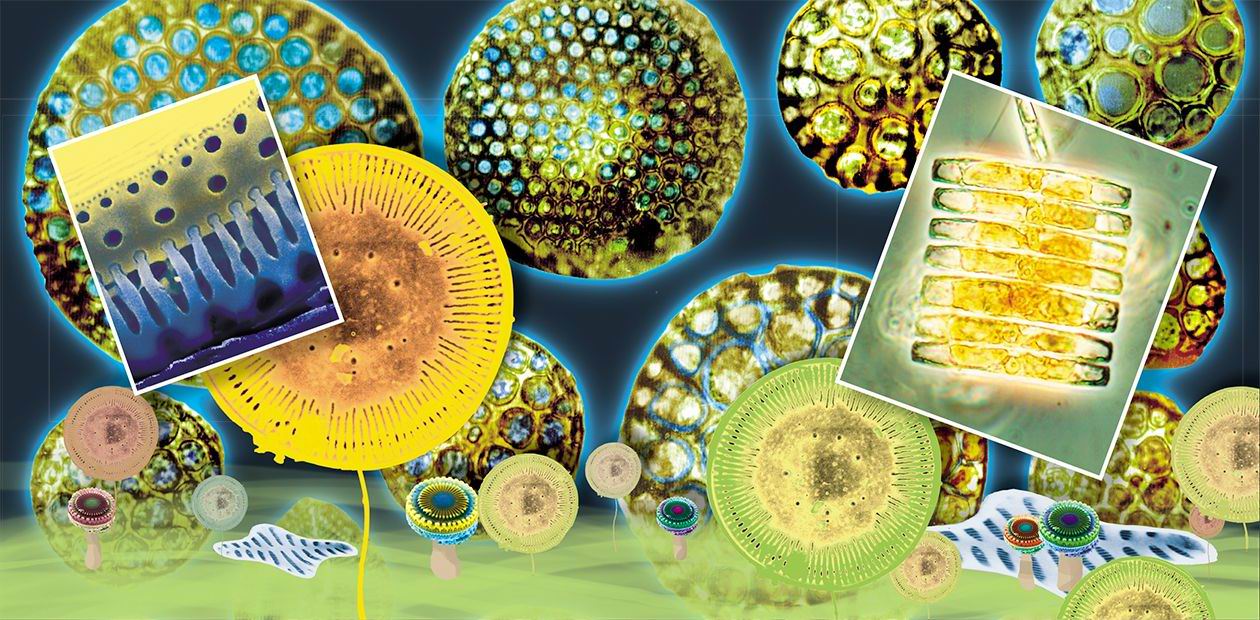The Planet Chronicles by Diatoms
Rapid development of diatoms resulted in bottom deposits enriched in silica at the expense of frustules of dead diatoms, which can stay fossilized for millions of years. In this way “diatomaceous” rocks form, some of which consist almost completely of diatom frustules, especially where calcium promoting dissolution of silica is in deficiency. Ancient sea diatomites, diatomaceous shales, and silts are known in many world regions, reaching several hundred meters thick in places
E. I. LOSEVA: Rapid development of diatoms resulted in bottom deposits enriched in silica at the expense of frustules of dead diatoms, which can stay fossilized for millions of years. In this way “diatomaceous” rocks form, some of which consist almost completely of diatom frustules, especially where calcium promoting dissolution of silica is in deficiency. Ancient sea diatomites, diatomaceous shales, and silts are known in many world regions, reaching several hundred meters thick in places.
Fossil complexes of diatoms allow us to reconstruct the paleogeographic situation of the past geological eras with a high degree of reliability, if the complexes contain extant species. Thus, revision of all known diatoms, both fossil and modern, carried out by scientists of the Komi Scientific Center of the Uralian Branch of the Russian Academy of Sciences, yielded a list of 995 species! As a result, the environments that existed at different stages of the Pleistocene have been reconstructed— a geological period embracing the latest 1.8 million years in the Earth history.
The information obtained from the areas where the deposits had been accumulated continuously is of special value. This is how a full geological record is formed, for example, in oceans or Lake Baikal, where the deposits of diatom frustules up to 600 meters thick embrace the time span of 8 million years! Unfortunately, the majority of diatom species have not survived, which is why their ecological features are inferred from comparison with findings of other organisms as well as with paleothermal, oxygen-isotope, and paleomagnetic scales.
R. CRAWFORD: Today diatoms are of major significance for the study of past and present environment: climate changes, cataclysmic events (such as volcanic eruptions and tsunami), anthropogenic effect…
It would not be possible to decode these chronologies if the cell walls were all the same but here the variation of the morphology plays a very important role.
The morphological analysis is needed in the sediment record because different species prefer different growth conditions. At a very coarse level the difference between say, a marine plankton and a freshwater mud sample is easy to recognize but the difference between slight changes in pH in the sediment record can be recognized only with experience.
Nevertheless countless biostratigraphers have used the diatom record to investigate the past history of their water body. Perhaps the most impressive demonstrations are those that showed the changes in the diatom record that took place around the time of the start of the industrial revolution that polluted our skies, caused pH of the rain water to fall and so increased the acidity of the lakes and streams. Our attention is now turning rather more to diatoms as bioindicators of changing temperatures on different time scales.
The diatom chronograph
The best results in deciphering of geological events with the help of diatoms were obtained when working with Cenozoic marine sediments which are younger than 45 million years, for by that time diatoms had “conquered” the great oceans. A telling example is a study of the history of the Bering Strait.
To construct the Cenozoic scale for the North Pacific region, we used materials of deep-sea drilling and data from sections in Kamchatka, Sakhalin, Japan, and California and performed accurate diatom zoning, with 15 zones of about 1 million of years on average
We are reminded that for almost 100 million years Eurasia and North America were connected by the Bering bridge, that is, the northern Pacific was a gigantic sea gulf. The strait formation that resulted in establishing connection between the Arctic and Pacific basins had significantly influenced the climate and the development of communities in the Northern Hemisphere.
The first opening of the strait was dated, on the basis of findings of mollusks of the genus Astarte, at 3.5—4.4 million years. The attempts to determine a more precise age failed. But recently, while studying the Sandy Ridge on the Alaska Peninsula we managed to determine the exact stratigraphic position of remains of the oldest astartes, because we found microplankton, ancient sea diatoms, in the samples. These findings allowed precise dating of the strait, adding more than a million years to its age: it turned out that Eurasia and North America were divorced 5.5—5.4 million years ago.
Diatoms in the Arctic: the reliable witnesses
Arctic ecosystems are considered to be especially susceptible to the effects of recent climatic change. Although a variety of factors make polar regions especially sensitive, changes in albedo or reflectivity of the Earth’s surface are major drivers of climatic change. With more warming, less snow and ice is present and so the heating of land and water is further accelerated. This is often referred to as a positive feedback system, and therefore makes any potential warming in Arctic regions a very serious issue
It is not surprising that not only scientists and politicians but the general public also are interested in getting reliable data on climatic changes in the Arctic. But long-term monitoring data are rarely available. For example, in the vast Canadian Arctic, only a few meteorological stations have been in existence for over 50 years.
Some examples of using natural archives of environmental change include the study of tree rings, coral reefs, ice cores and cave deposits. However, one of the most powerful approaches used to reconstruct past environmental trends is paleolimnology, which can broadly be defined as the science that uses the physical, chemical and biological information archived in lake, pond and river sediments to reconstruct past environmental changes. As sediments slowly accumulate information from a variety of sources (such as algal remains, invertebrates, chemical precipitates, pollen grains, soil particles), a surprisingly clear record of past environmental changes can often be reconstructed.
The main requirement for a suitable coring site is an area where sediments are accumulating in an orderly and largely undisturbed manner. Once an appropriate sediment core is collected, typically the next step is to develop an accurate depth-time profile for the sediment core (i.e., dating the sediment profile by establishing a geochronology). This is often done using radioisotopes, such as 210Pb and 137Cs for the most recent sediments (e. g., the last 100 — 150 years) or 14C for older material.
From a biological perspective almost everything living in the lake or water body leaves some form of morphological (i.e., diatom valves) or biogeochemical (e.g., fossil pigments) indicator. And diatom algae are in that sense one of the most ideal and frequently used indicators of past environments.
Diatoms represent the dominant algal group in many Arctic lakes. In the High Arctic, even “warmer” years are still characterized by cold waters. During colder years in some High Arctic lakes, a persistent ice cover may exist all year round, with only a small moat of ice-free conditions available in the littoral zone. During warmer years, ice cover may thaw completely during the short summer.
Diatoms respond closely to all these changes. If a lake is characterized by extensive snow and ice cover, then diatoms adapted to living in the open water plankton will be less competitive, whereas most of the primary production will come from shallow water, ice-free habitats from the littoral zone moat. With less and less ice cover, progressively deeper water assemblages will be more competitive.
Attempting to reconstruct past lake ice regimes is only one of the many ways that diatoms can be used in high latitude climate reconstructions. Another major research effort is to track past migrations in the position of tree line. Much like water passing through tea leaves, water passing through coniferous litter is coloured by dissolved organic carbon compounds and as a result the chemical and optical properties of the drainage water are changed.
Besides illumination changes paleolimnology can reveal dynamics and other water body characteristics — changes of nutritive materials flow, habitat transformation (for example, appearance and disappearance of mosses — substratum, to which algae can attach).
Paleolimnological approaches can be used for a wide spectrum of other applications in Arctic settings. For example, sockeye salmon are important components of Pacific coast ecosystems. They are characterized by an anadromous life cycle, meaning they hatch in nursery lakes, but then, after spending 1 to 3 years in the freshwater environment, they migrate to the open ocean where they accumulate over 95 % of their biomass. After spending a few years in the marine setting, sockeye salmon return, with remarkable fidelity, to their native nursery lake to spawn and die. These lakes, which are both the nurseries and the graveyards to the sockeye salmon, may witness salmon returns that can number in the millions of fish. Not surprisingly, all these decaying carcasses represent a large subsidy of marine-derived nutrients for the lake environment. As diatoms are excellent indicators of nutrient levels, we have been able to use changes in past diatom populations to reconstruct past sockeye salmon runs. Similar approaches can be used to track changes in other animal groups, such as arctic seabirds.
Thus the diatom chronicles of northern latitudes might be interesting for various specialists, including historians, and even fishermen. Identical approaches can and are being used in the Southern Hemisphere in Antarctica and nearby Sub-Antarctic islands.
M. POULIN: The bulk of the microalgal populations can be observed in the bottom 5 to 10 centimeters of Arctic sea ice giving a brownish to golden-brown coloration which is caused by the pigmentation contained in the algae. The lower sections of Arctic sea ice offer a habitat highly suitable for the settlement and growth of microalgae. This habitat consists of a network of minuscule brine pockets and very small channels and capillaries constantly connected with the underlying waters that provide nutrients to the bottom ice algae. This nutrient supply may vary with the stratification of the water column and tidal cycles, thereby limiting the ice algal production.
The algal growth in the bottom ice usually starts in late winter/early spring, as increasing light intensity triggers cells to divide. Microalgae still remain low in abundance but rapidly increase in April to reach maximum concentrations in May. The decline of the ice algal growth is associated with melting processes. Increasing light intensity and air temperature during the spring season will contribute to melting of the snow and decay of the ice. This ultimately releases the ice algae into the water column which will become a food source to pelagic herbivores or simply sink to the sea floor.
The ice-associated ecosystem is complex, so many factors that influence the environment changes influence ice communities life too. The sea ice extent and thickness decreased by 7 % over the last 25 years, and it is expected that the sea ice extent and thickness will be dramatically modified over the next 50 years.
Global warming is here to stay and it will affect not only the large animals and people that live above the ice, but also the tiny microscopic inhabitants of the ice itself!
Paleotsunami hunters
The tsunami is one of the most threatening of natural phenomena, which brings irreplaceable losses and tremendous ecological and financial damage. It is extremely difficult to forecast such catastrophes. Nevertheless, studying traces of tsunamis that happened in the pre-historic past allows us to follow the frequency with which the most destructive tsunamis appeared, direction of the sea wave blow and the distance of its penetration into the land, as well as to determine the degree of its effect on the natural development of ecosystems. The most effective method for the purposes is the analysis of the diatom flora.
Traces of ancient tsunamis are best seen in peatbogs — real natural “traps” for the material coming from outside. For example, when studying sand streaks in peatbogs in the central part of Kunashir (Kuriles) one kilometer from the shore, six streaks of tsunami-related sand were found. The sand contains both marine and fresh-water diatoms including inhabitants of the open sea. They were evidently brought by powerful sea floods penetrating far inland — a consequence of paleotsunami.
Analysis of the diatom complex shows that tsunamis had a serious effect on some ecological parameters of the environment, for example, typically acidic bogs became more alkaline. A study of paleotsunami-related deposits on Zelenyi Island (Kuriles) with low flat relief showed that during the strongest tsunamis the wave flooded the island almost completely.



















